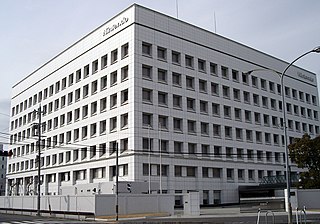Sasaki Kojirō, often anglicised to Kojirō Sasaki, was a prominent Japanese swordsman widely considered a master of his craft, born in Fukui Prefecture. He lived during the Azuchi–Momoyama and early Edo periods and is most remembered for his death while battling Miyamoto Musashi in 1612.

Miyamoto Yuriko was a Japanese novelist, short-story writer, social activist, and literary critic active during the Taishō and early Shōwa periods of Japan. She is best known for her autobiographical fiction and involvement in proletarian and women's liberation movements.
A jō (杖:じょう) is an approximately 1.27-metre (4.2 ft) wooden staff, used in some Japanese martial arts. The martial art of wielding the jō is called jōjutsu or jōdō. Also, aiki-jō is a set of techniques in aikido which uses the jō to illustrate aikido's principles with a weapon. The jō staff is shorter than the bō. Today, the jō is still used by some Japanese police forces.
Miyamoto is a Japanese surname. Notable people with the surname include:

Kenji or Kenzi is a Japanese given name for boys.

Nintendo Entertainment Analysis & Development Division , commonly abbreviated as Nintendo EAD, formerly Nintendo Research & Development 4 Department, was formerly the largest software development division inside of Nintendo. It was preceded by the Creative Department, a team of designers with backgrounds in art responsible for many different tasks, to which Shigeru Miyamoto and Takashi Tezuka originally belonged. Both served as managers of the EAD studios and were credited in every game developed by the division, with varying degrees of involvement. Nintendo EAD was best known for its work on games in the Donkey Kong, Super Mario, The Legend of Zelda, F-Zero, Star Fox, Animal Crossing, Pikmin and Wii series.
Kenji Tokitsu is a Japanese author and practitioner of Japanese martial arts. Tokitsu has also written a scholarly work about the legendary swordsman Musashi Miyamoto. He holds doctorates in sociology and in Japanese language and civilization.
Shinmen Sokan was a Japanese lord, daimyō of the Shinmen clan during the middle of the Sengoku period. Sokan was known as a rather petty daimyō in the mountainous regions of Sakushu, which was west of Kyoto. Even though this was so, the Shinmen clan had very good ties with that of the Hirata family, leading to the Shinmen receiving substantial support. One such swordsman of note that served under Sokan was the famous Shinmen Munisai, the father of the legendary swordsman Miyamoto Musashi. In 1589, Sokan ordered Munisai to kill Honiden Gekinosuke for unknown reasons. As a result, Munisai was forced to leave his village of Miyamoto.
Shinmen clan was a Japanese kin group that flourished during the 15th–16th and 17th centuries of Japan. The clan resided in Western Kyoto.
Tsutsumi Hōzan (堤宝山), also known as Tsutsumi Yamashiro no kami Hōzan (堤山城守宝山), was a swordsman during the Sengoku period of Japan, who founded Hōzan ryū.

The Japan Open Golf Championship is Japan's national open golf championship. As of 2016, it is one of the three richest tournaments on the Japan Golf Tour, with a prize fund of ¥200 million. It is also the tour's designated "Premier event" for the purposes of the Official World Golf Ranking, with a minimum winner's points allocation of 32 points. The winner also receives an invitation to the next year's Open Championship.
Tadashima Akiyama, also called Akiyama of Tajima, was a Japanese samurai of the Azuchi–Momoyama period who hailed from Tajima Province. A rather unknown figure, he is largely remembered for his defeat at the hands of the young Miyamoto Musashi, who was sixteen at the time. It has been concluded that Akiyama openly challenged Musashi.

Kenji Miyamoto was a Japanese communist politician and Japanese Communist Party (JCP) leader from 1958 until 1977.
Rie Arikawa is a Japanese ice dancing coach and former competitor. With Kenji Miyamoto, she won two Japanese national titles and competed at seven ISU Championships.

Kenji Miyamoto is a Japanese figure skating choreographer, coach, and former competitive ice dancer. He skated with Rie Arikawa, winning two Japanese national titles, and then with Nakako Tsuzuki. During his career, he competed at a total of ten ISU Championships.

Nakako Tsuzuki is a Japanese former competitive ice dancer. A six-time Japanese national champion, she competed at five World Championships and six Four Continents Championships.
The Mishima Yukio Prize is a Japanese literary award presented annually. It was established in 1988 in memory of author Yukio Mishima. The Mishima Yukio Prize is explicitly intended for work that "breaks new ground for the future of literature," and prize winners tend to be more controversial and experimental than winners of the more traditional Akutagawa Prize. It is awarded in the same annual ceremony as the Yamamoto Shūgorō Prize, which was established by the same sponsor in 1988 to recognize popular writing and genre fiction.

5-MeO EiPT is a psychedelic of the tryptamine class that has been sold online as a designer drug.
Events in the year 1908 in Japan. It corresponds to Meiji 41 (明治41年) in the Japanese calendar.
Japan Football Hall of Fame (日本サッカー殿堂) is housed at the Japan Football Museum (ja:日本サッカーミュージアム), in JFA House in Bunkyo, Tokyo. The Hall aims to celebrate the achievements of the all-time top Japanese footballing players, managers and other person who have become significant figures in the history of the Japanese game.






